A common misconception is that state collections actions are less serious than federal collections actions. Contrary to popular belief, collections actions taken by states to claim unpaid debt are more aggressive than those taken by the IRS and can disrupt your daily life by preventing you from driving, working, or accessing your direct deposit paycheck. When faced with state tax collections actions, it is important to consult an experienced tax professional as soon as possible so that you can avoid the serious consequences of unpaid state tax debt.
The consequences of unpaid state tax debt
State taxing authorities must be taken very seriously, as they can be extremely aggressive. Some of their collection remedies are permanent and cannot be changed once they are implemented.
There are four types of state taxes that can result in collections actions if unpaid. They are:
- Personal income tax
- Business sales & use tax
- Unemployment tax
- Business equipment tax
Regardless of the type of state taxes you owe, the government will act quickly to begin collections actions and begin punitive measures to further pressure you to pay off your tax debt. Time is of the essence, so it’s critical to enlist the help of a professional who can begin working on the issue as quickly as possible, before viable options are eliminated.
Unresolved tax debt can lead to an array of serious consequences, including:
- Wage garnishment
- Vehicle tag registration suspension
- Bank levies
- Tax lien being filed
- Professional licenses suspended
- Driver’s license suspension
When faced with state tax debt, it is important to act quickly to resolve your debt before the government seizes your accounts. Because your options to resolve your debt vary widely by state, an experienced tax professional can help you navigate your state’s process before permanent collections actions are taken.
State tax relief solutions from the experts at Key Tax Group
When serious consequences are at stake, you need serious tax law representation. At Key Tax Group, we specialize in state tax resolution nationwide. As the premier tax law firm in the U.S., we are one of the very few firms that offer excellence in tax resolution services in every state. Our focus is simple: We protect our clients’ paychecks and savings from aggressive tax collections while helping them resolve their tax issues. For more information on how we can help you resolve your state tax debt, contact our office today.
